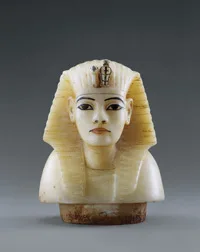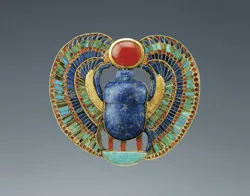Tutankhamun, one of the last kings of Egypt’s 18th Dynasty, died under mysterious circumstances around age 18 or 19 in the ninth year of his reign (1323 B.C.). Yet the fascination surrounding his life and death still endures. If you are one of the thousands who yearn to know more about King Tut, you’ll be happy to know that the renowned Tutankhamun and the Golden Age of the Pharaohs exhibition has reached its only Northeast destination, and its final stop on the current U.S. tour, The Franklin Institute in Philadelphia. The exhibit will be on view from February 3 until September 30, giving Americans one more chance to experience the world that remains of Egyptian royal life 3,000 years ago. After Philadelphia, the exhibit heads to London.

There has not been a King Tut exhibit in the United States for 26 years. This means that even if you saw it last time around, chances are you’re ready to go again as the parent instead of the child. This larger and even more intriguing exhibition features approximately 130 artifacts from the tombs of King Tut and his contemporaries. Since it began its four-city tour of the U.S. in June 2005, the exhibit has had a record 300,000 tickets reserved, illustrating the young king’s allure in this country.
Visitors to Tutankhamun and the Golden Age of the Pharaohs will progress through multiple galleries filled with artifacts from the tombs of King Tut, several of his relatives and 18th Dynasty (1555 B.C. to 1305 B.C.) contemporaries. On display are 50 of Tutankhamun’s burial objects, including his royal diadem — the gold crown discovered encircling the head of his mummified body that he likely wore as king — and one of the gold and precious stone inlaid canopic coffinettes that contained his mummified internal organs. Gross to parents, perhaps, but fascinating for kids. More than 70 objects from tombs of other 18th Dynasty royals, as well as several commoners, are also part of the exhibit. All of the treasures are between 3,300 and 3,500 years old.
A special section of the exhibition explores the mystery of Tutankhamun’s death using the marvels of modern CT scanning technology. The scanning of Tut’s mummy is part of a landmark, five-year Egyptian research and conservation project, partially funded by National Geographic, which will CT-scan the ancient mummies of Egypt.
Admission to the exhibit requires a timed-entry ticket that specifies a 30-minute window for entering the show that must be purchased in combination with General Admission to the Museum. Once you have entered the exhibition, you can stay as long as you like, but to make sure you can enter at your preferred date and time, it is recommended that tickets be reserved in advance.
Several hotels in the city are offering a King Tut Hotel Package which includes two exclusive, VIP Tickets to the exhibit so visitors can see it any time they like. Booking the Hotel Package is the only way to get these VIP, un-timed tickets to the exhibition. Package prices vary from $175 to $402 per night, depending on the hotel.
To pre-reserve tickets, or for more information, visit www.fi.edu/tut or www.kingtut.org. To learn more about Philadelphia and to book the hotel package, visit www.gophila.com.






















